recommended oil BUICK REGAL 1995 Owners Manual
[x] Cancel search | Manufacturer: BUICK, Model Year: 1995, Model line: REGAL, Model: BUICK REGAL 1995Pages: 340, PDF Size: 17.16 MB
Page 157 of 340
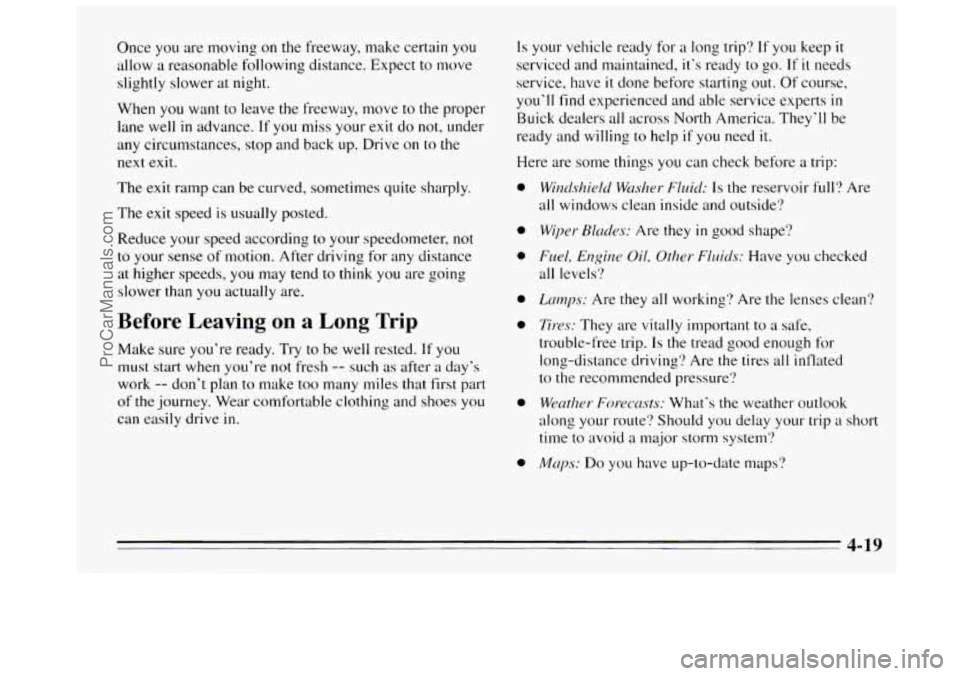
Once you are moving on the freeway, make certain you
allow a reasonable following distance. Expect to move
slightly slower at night.
When you want to leave the freeway, move to the proper
lane
well in advance. If you miss your exit do not, under
any circumstances, stop and back up. Drive
on to the
next exit.
The exit ramp can be curved, sometimes quite sharply.
The exit speed is usually posted.
Reduce your speed according to your speedometer, not
to
your sense of motion. After driving for any distance
at higher speeds,
you may tend to think you are going
slower than
you actually are.
Before Leaving on a Long Trip
Make sure you’re ready. Try to be well rested. If you
must start when you’re not fresh -- such as after a day’s
work
-- don’t plan to make too many miles that first part
of the journey. Wear comfortable clothing and shoes you
can easily drive in.
Is your vehicle ready for a long trip? If you keep it
serviced and maintained. it’s ready to go. If it needs
service, have
it done before starting out. Of course,
you’ll find experienced and able service experts
in
Buick dealers all across North America. They’ll be
ready and willing to help if you need
it.
Here are some things you can check before a trip:
0
0
0
0
0
0
Windshield Wc~slwr Fluid: Is the reservoir full‘? Are
all windows clean inside and outside?
Wiper Blades: Are they in good shape?
Fuel, Eqirze Oil, Other Fluids: Have you checked
all levels‘?
Lamps: Are they all working? Are the lenses clean?
Tires: They are vitally important to a safe,
trouble-free trip.
Is the tread good enough for
long-distance driving? Are the tires all inflated
to the recommended pressure‘?
Weather Fowcvzsrs: What’s the weather outlook
along your route? Should you delay your trip
a short
time to avoid a major storm system‘?
A4up.s: Do you have up-to-date maps?
4-19
ProCarManuals.com
Page 218 of 340
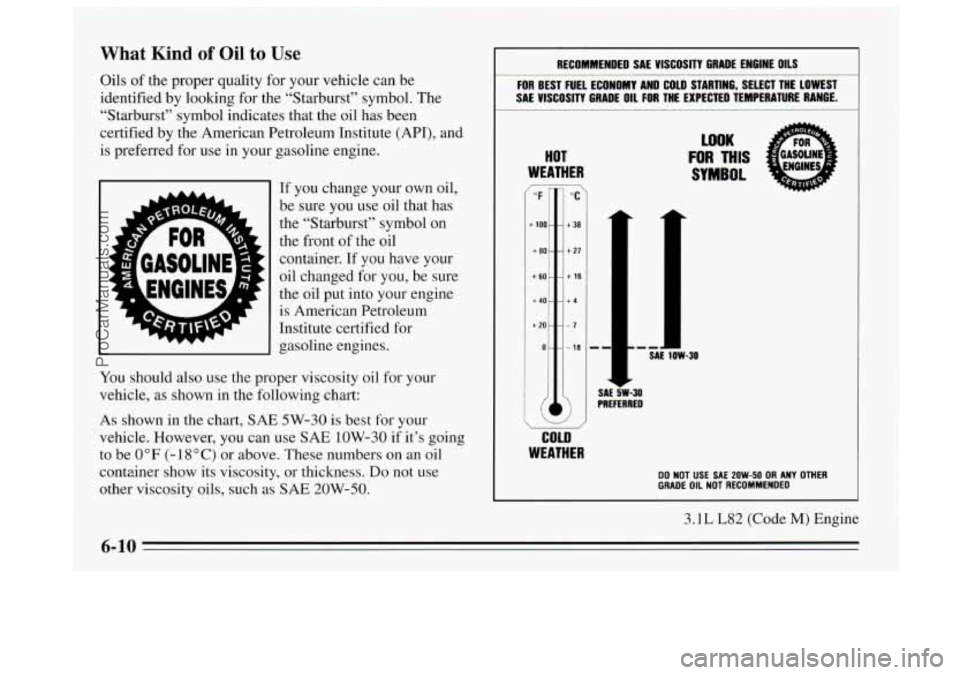
What Kind of Oil to Use
Oils of the proper quality for your vehicle can be
identified by looking for the “Starburst” symbol. The
“Starburst” symbol indicates that the oil has been
certified by the American Petroleum Institute (API), and
is preferred for use in your gasoline engine.
If you change your own oil,
be sure you use oil that has
the “Starburst” symbol on
the front of the oil
container.
If you have your
oil changed for you, be sure
the oil put into your engine
is American Petroleum
Institute certified for
gasoline engines.
You should also use the proper viscosity oil for your
vehicle, as shown in the following chart:
As shown in the chart, SAE 5W-30 is best for your
vehicle. However, you can use SAE 1OW-30 if it’s going
to be
0°F (- 18°C) or above. These numbers on an oil
container show its viscosity, or thickness.
Do not use
other viscosity oils, such as SAE
20W-50.
RECOMMENDED SAE VISCOSITY GRADE ENGINE OILS ~~~~~ ~ ~ ~~ ~~~
FOR BEST FUEL ECONOMY AND COLD STARTING, SELECT THE LOWEST
SAE VISCOSITY GRADE OIL
FOR THE EXPECTED TEMPERATURE RANGE.
HOT
WEATHER
COLD
WEATHER
FOR THIS
LOOK
SYMBOL @&
SAE 1OW-30
r
RED
DO NOT USE SAE 2OW-50 OR ANY OTHER
GRADE OIL NOT RECOMMENDED
3.1L L82 (Code M) Engine
6-10
~
ProCarManuals.com
Page 219 of 340
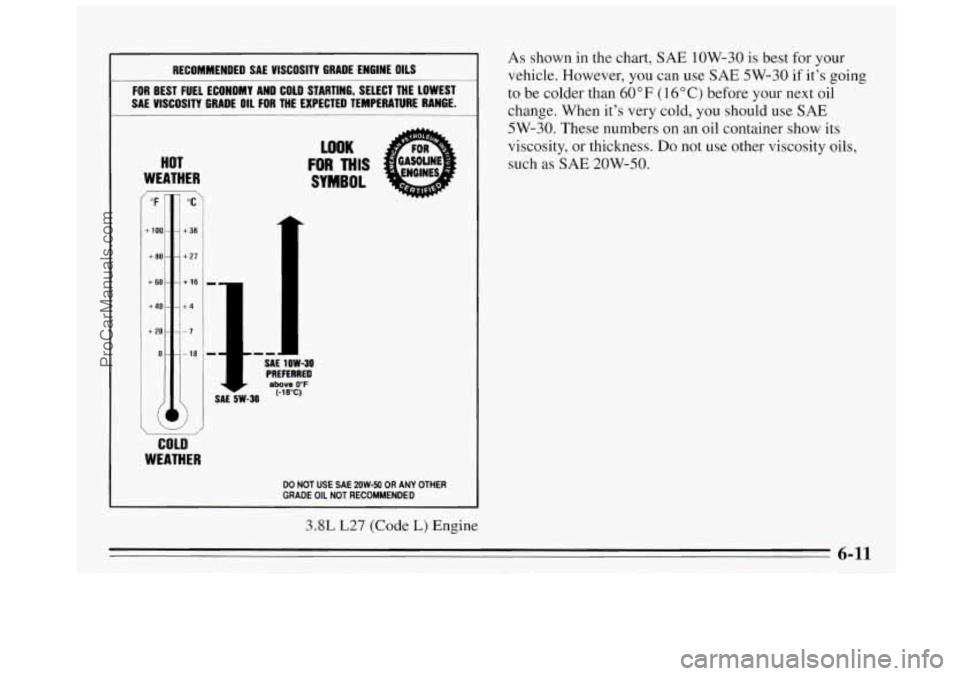
RECOMMENDED SAE VISCOSITY GRADE ENGINE OILS
FOR BEST FUEL ECONOMY AND COLD STARTING, SELECT THE LOWEST
SAL VISCOSITY GRADE
OIL FOR THE EXPECTED TEMPERATURE RANGE. -
HOT
WEATHER
- "F "C
-100- - +38
+BO- - +27
+60--+16
+40--+4
+20---7
0---18
SAL SW-30
LOOK
FOR THIS
SYMBOL
SAE 1OW-30 PREFERRE0 above 0°F (-18OC)
COLD
WEATHER
DO NOT USE SAE 2OW-50 OR ANY OTHER
GRADE OIL NOT RECOMMENDED
3.8L L27 (Code L) Engine
As shown in the chart, SAE 1OW-30 is best for your
vehicle. However, you can use
SAE 5W-30 if it's going
to be colder than
60°F ( 16" C) before your next oil
change. When it's very cold, you should use
SAE
5W-30. These numbers on an oil container show its
viscosity, or thickness.
Do not use other viscosity oils,
such as
SAE 20W-50.
6-11
ProCarManuals.com
Page 225 of 340
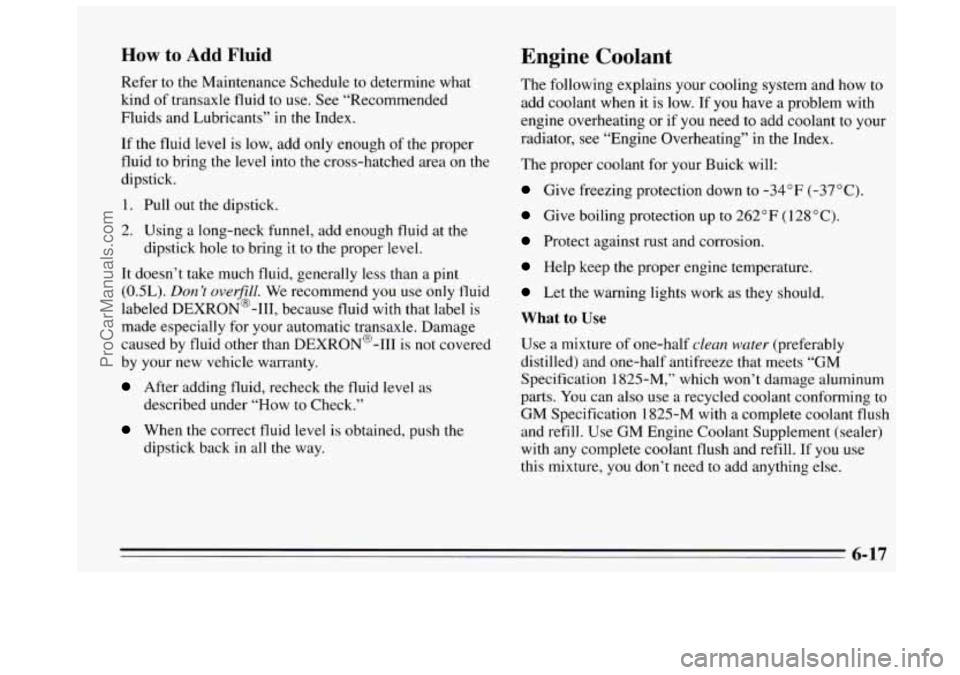
How to Add Fluid
Refer to the Maintenance Schedule to determine what
kind of transaxle fluid to use. See “Recommended
Fluids and Lubricants”
in the Index.
If the fluid level is low, add only enough of the proper
fluid to bring the level into the cross-hatched area on the
dipstick.
1. Pull out the dipstick.
2. Using a long-neck funnel, add enough fluid at the
dipstick hole
to bring it to the proper level.
It doesn’t take much fluid, generally less than a pint
(OSL). Don ’t ouefill. We recommend you use only fluid
labeled DEXRON@-111, because fluid with that label is
made especially for your automatic transaxle. Damage
caused by fluid other than DEXRON@-I11 is not covered
by your new vehicle warranty.
After adding fluid, recheck the fluid level as
described under “How
to Check.”
When the correct fluid level is obtained, push the
dipstick back in all the way.
Engine Coolant
The following explains your cooling system and how to
add coolant when it is low. If you have a problem with
engine overheating or if
you need to add coolant to your
radiator, see “Engine Overheating” in the Index.
The proper coolant for your Buick will:
Give freezing protection down to -34°F (-37°C).
Give boiling protection up to 262 OF (1 28 O C).
Protect against rust and corrosion.
Help keep the proper engine temperature.
Let the warning lights work as they should.
What to Use
Use a mixture of one-half clean water (preferably
distilled) and one-half antifreeze that meets “GM
Specification
1825-M,” which won’t damage aluminum
parts. You can also use a recycled coolant conforming to
GM Specification 1825-M with a complete coolant flush
and refill. Use GM Engine Coolant Supplement (sealer)
with any complete coolant flush and refill.
If you use
this mixture, you don’t need to add anything else.
~
6-17
ProCarManuals.com
Page 250 of 340
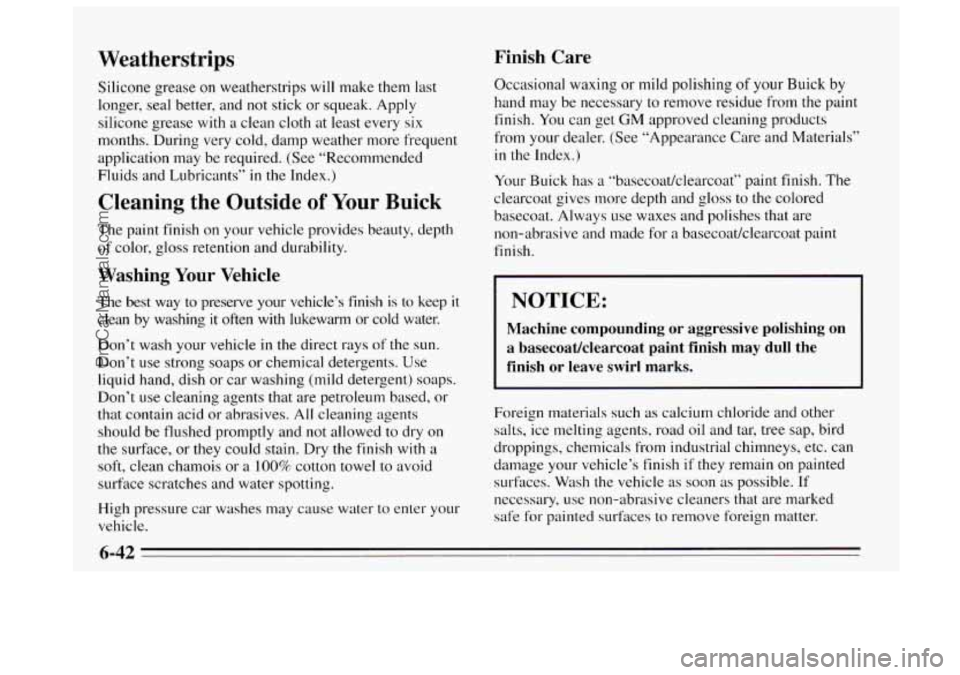
Weatherstrips
Silicone grease on weatherstrips will make them last
longer, seal better, and not stick or squeak. Apply
silicone grease with
a clean cloth at least every six
months. During very cold, damp weather more frequent
application may be required. (See “Recommended
Fluids and Lubricants”
in the Index.)
Cleaning the Outside of Your Buick
The paint finish on your vehicle provides beauty, depth
of color, gloss retention and durability.
Washing Your Vehicle
The best way to preserve your vehicle’s finish is to keep it
clean by washing it often with lukewarm or cold water.
Don’t wash your vehicle in the direct rays
of the sun.
Don’t use strong soaps or chemical detergents. Use
liquid hand, dish or car washing (mild detergent) soaps.
Don’t use cleaning agents that are petroleum based,
or
that contain acid or abrasives. All cleaning agents
should be flushed promptly and not allowed to dry on
the surface, or they could stain. Dry
the finish with a
soft, clean chamois or a 100% cotton towel to avoid
surface scratches and water spotting.
High pressure car washes may cause water to enter your
vehicle.
Finish Care
Occasional waxing or mild polishing of your Buick by
hand may be necessary to remove residue from the paint
finish. You can get GM approved cleaning products
from your dealer. (See “Appearance Care and Materials”
in the Index.)
Your Buick has
a “basecoat/clearcoat” paint finish. The
clearcoat gives more depth and gloss to the colored
basecoat. Always use waxes and polishes that are
non-abrasive and made for
a basecoatklearcoat paint
finish.
I NOTICE:
Machine compounding or aggressive polishing on
a basecoatklearcoat paint finish may dull the
finish or leave swirl marks.
Foreign materials such as calcium chloride and other
salts, ice melting agents, road oil and tar, tree sap, bird
droppings, chemicals from industrial chimneys, etc. can
damage your vehicle’s finish
if they remain on painted
surfaces. Wash the vehicle
as soon as possible. If
necessary, use non-abrasive cleaners that are marked
safe for painted surfaces to remove foreign matter.
6-42
ProCarManuals.com
Page 269 of 340
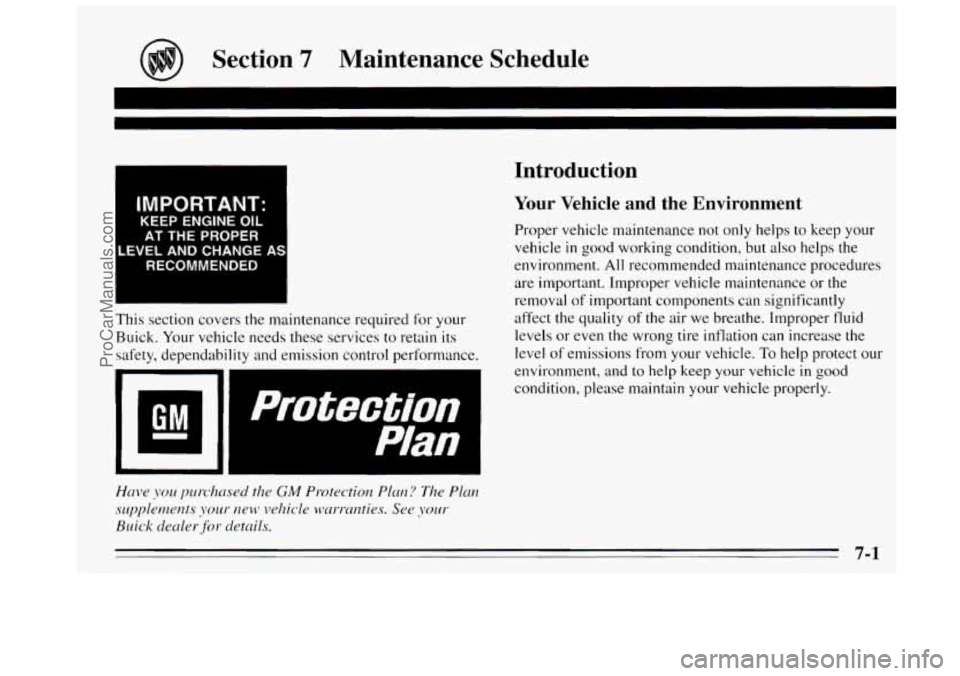
Section 7 Maintenance Schedule
IMPORTANT:
KEEP ENGINE OIL
AT THE PROPER
.EVEL AND CHANGE AI
RECOMMENDED
This section covers the maintenance required for your
Buick. Your vehicle needs these services
to retain its
safety, dependability
and emission control performance.
Protection
Plan
ui
Introduction
Your Vehicle and the Environment
Proper vehicle maintenance not only helps to keep your
vehicle
in good working condition, but also helps the
environment. All recommended maintenance procedures
are important. Improper vehicle maintenance or the
removal
of important components can significantly
affect the quality
of the air we breathe. Improper fluid
levels or
even the wrong tire inflation can increase the
level of emissions from your vehicle. To help protect our
environment, and to help keep
your vehicle in good
condition, please maintain your vehicle properly.
ProCarManuals.com
Page 274 of 340
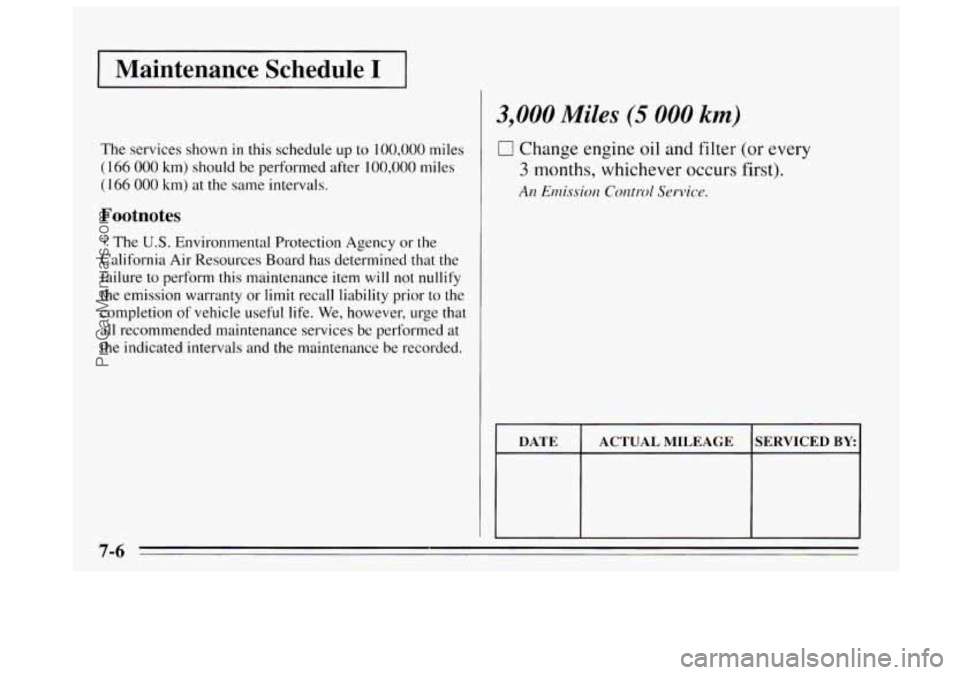
Maintenance Schedule I
3,000 Miles (5 000 km)
The services shown in this schedule up to 100,000 miles
(166 000 km) should be performed after 100,000 miles
(1 66 000 km) at the same intervals.
Footnotes
I* The U.S. Environmental Protection Agency or the
California Air Resources Board has determined that the
failure to perform this maintenance item will not
nullify
the emission warranty or limit recall liability prior to the
completion
of vehicle useful Me. We, however, urge that
all recommended maintenance services be performed at
the indicated intervals and
the maintenance be recorded.
0 Change engine oil and filter (or every
3 months, whichever occurs first).
An Etnissiorz Cmttrol Service.
DATE SERVICED BY ACTUAL MILEAGE
ProCarManuals.com
Page 294 of 340
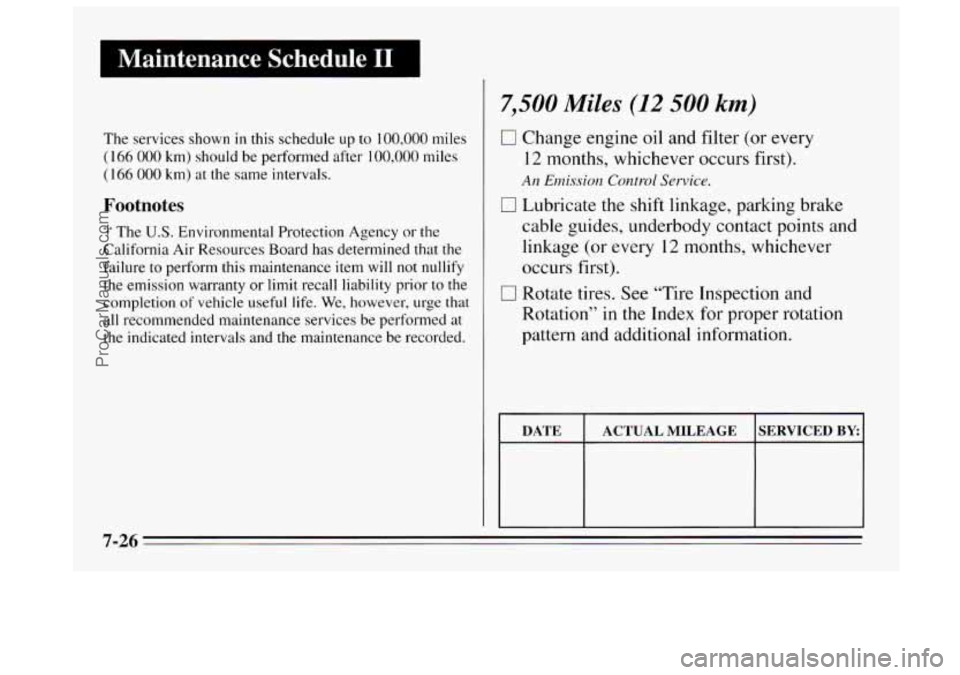
I Maintenance Schedule I1 I
The services shown in this schedule up to 100,000 miles
(164 000 km) should be performed after 100,000 miles
(166 000 km) at the same intervals.
Footnotes
-1 The U.S. Environmental Protection Agency or the
California Air Resources Board has determined that the
failure
to perform this maintenance item will not nullify
the emission warranty or limit recall liability prior to
the
completion of vehicle useful life. We, however, urge that
all recommended maintenance services
be performed at
the indicated intervals and the maintenance be recorded.
7,500 Miles (12 500 km)
0 Change engine oil and filter (or every
12 months, whichever occurs first).
An Emission Control Service.
0 Lubricate the shift linkage, parking brake
cable guides, underbody contact points and
linkage (or every
12 months, whichever
occurs first).
0 Rotate tires. See “Tire Inspection and
Rotation” in the Index for proper rotation
pattern and additional information.
DATE SERVICED BY. ACTUAL MILEAGE
7-26
ProCarManuals.com
Page 308 of 340
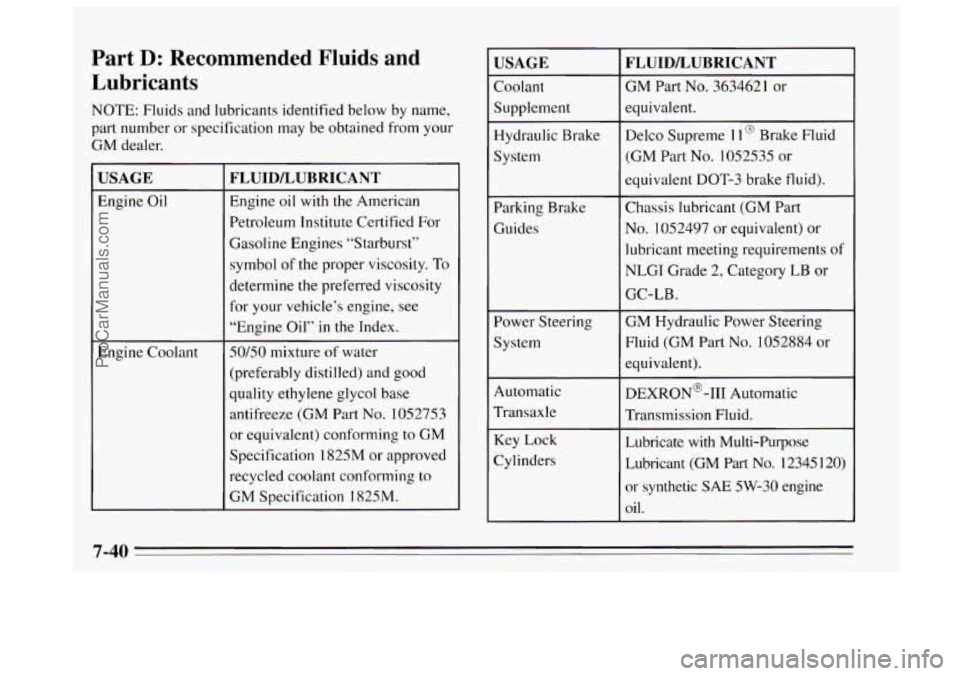
Part D: Recommended Fluids and
Lubricants
NOTE: Fluids and lubricants identified below by name,
part number or specification may be obtained from your
GM dealer.
FLUIDLUBRICANT
Engine oil with the American
Petroleum Institute Certified For
Gasoline Engines “Starburst”
symbol of the proper viscosity.
To
determine the preferred viscosity
for your vehicle’s engine, see
“Engine Oil” in the Index.
Soh0 mixture of water
(preferably distilled) and good
quality ethylene glycol base
antifreeze (GM Part
No. 1052753
or equivalent) conforming to GM
Specification 1825M or approved
recycled coolant conforming
to
GM Specification 1825M.
USAGE
Coolant
Supplement
Hydraulic Brake System
Parking Brake Guides
Power Steering
System
Automatic
Transaxle
Key Lock
Cylinders
FLUIDLUBRICANT
GM Part No. 3634621 or
equivalent.
Delco Supreme
1 1 @ Brake Fluid
(GM Part
No. 1052535 or
equivalent DOT-3 brake fluid).
Chassis lubricant (GM Part
No. 1052497 or equivalent) or
lubricant meeting requirements
of
NLGI Grade 2, Category LB or
GC-LB.
GM Hydraulic Power Steering
Fluid (GM Part
No. 1052884 or
equivalent).
DEXRON@-I11 Automatic
Transmission Fluid.
Lubricate with Multi-Purpose
Lubricant (GM Part
No. 12345 120)
or synthetic SAE 5W-30 engine
oil.
7-40
ProCarManuals.com
Page 309 of 340
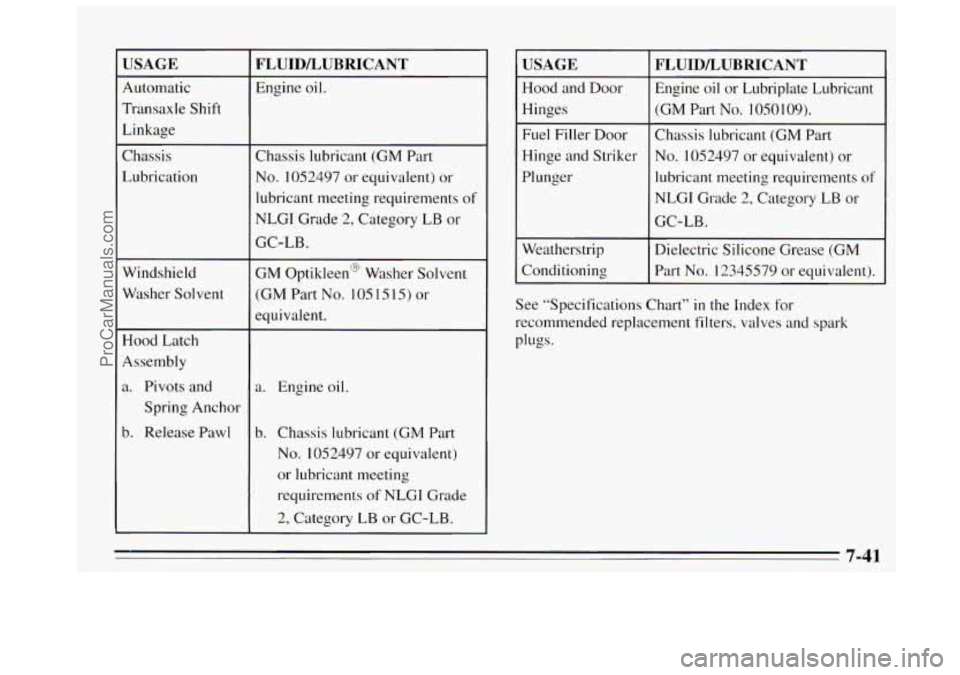
I USAGE
Automatic
Transaxle Shift
Linkage
Chassis
Lubrication
Windshield Washer Solvent
Hood Latch
Assembly
a. Pivots and
Spring Anchor
b. Release Pawl
FLUIDLUBRICANT
Engine oil.
Chassis lubricant
(GM Part
No. 1052497 or equivalent) or
lubricant meeting requirements of
NLGI Grade
2, Category LB or
GC-LB.
GM Optikleen@ Washer Solvent
(GM Part
No. 105 IS 15) or
equivalent.
a. Engine
oil.
b. Chassis lubricant (GM Part
No. 1052497 or equivalent)
or lubricant meeting
requirements
of NLGT Grade
2, Category LB or GC-LB.
USAGE
Hinge and Striker Chassis
lubricant (GM Part
Fuel Filler Door (GM
Part
No. 10501 09). Hinges Engine
oil or
Lubriplate Lubricant
Hood and Door
FLUIDLUBRICANT
lubricant
meeting requirements of Plunger
No. 1052497 or equivalent) or
NLGI Grade
2, Category LB or
GC-LB.
Weatherstrip
recommended replacement filters, valves and spark
See
“Specifications Chart”
in the Index for
Part
No. 12345579
or equivalent).
Conditioning Dielectric
Silicone Grease
(GM
plugs.
7-41
ProCarManuals.com